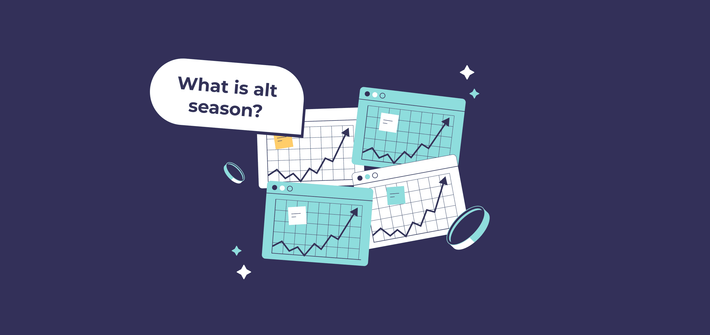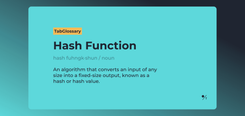What Is Altseason? A Beginner's Guide to the Crypto Rally
You've heard of a crypto bull run, but what about the 'Altseason'?
That’s the moment when altcoins, from household names like Ethereum and Solana to obscure tokens you’ve barely heard of, explode in value, sometimes outpacing Bitcoin. These surges aren’t accidents; they follow patterns, psychology, and timing.
If you can spot the signs early, altseason isn’t just exciting. It’s profitable. In this guide, we’ll show you what is altseason, what drives it, how to recognize it, and how to ride it.
Key takeaways
- Altseason is the moment when altcoins explode in value, sometimes outpacing Bitcoin.
- It happens when investors who’ve already made strong gains on Bitcoin start to rotate their profits into altcoins.
- Catching the alt season early isn’t easy, but there are reliable signals that seasoned traders keep an eye on.
- Altseason offers some of the most dramatic wealth-building opportunities in crypto, but those opportunities come hand in hand with extreme volatility and risk.
Altseason vs. bull run: What’s the difference?
To grasp what altseason is, it helps first to separate it from a standard crypto bull run.
A bull run is the big picture: a broad, market-wide uptrend where prices across most digital assets climb steadily. In this phase, Bitcoin (BTC) usually takes the lead. Its rally pulls sentiment higher, and most other cryptocurrencies simply follow in its wake. Think of it as a tide of optimism lifting the whole market as fresh capital flows in.
Altseason, however, is different. It doesn’t replace the bull run. It happens inside it. It’s that moment when the spotlight shifts from Bitcoin to the rest of the crypto market. Traders and investors who’ve already made strong gains on Bitcoin start rotating their profits into altcoins (everything that isn’t BTC), hunting for higher-risk, higher-reward plays.
This wave of capital rotation is what sets altcoin season apart: instead of Bitcoin leading the charge, its altcoins explode in value, sometimes at a much faster pace.
In short, the bull run is the tide, but altseason is the fireworks.
How to spot an Altseason
Spotting the alt season early isn’t easy, but there are reliable signals that seasoned traders keep an eye on. Most of them revolve around one thing: watching where the money and attention are moving.
1. Bitcoin dominance (BTCD)
The go-to indicator is Bitcoin Dominance, the share of the total crypto market cap that belongs to BTC. In the early stages of a bull run, Bitcoin’s dominance is usually high, since most new capital piles into BTC first. But when altseason kicks in, that dominance starts to fall. A sharp, sustained drop means funds are rotating out of Bitcoin and flooding into altcoins, shrinking Bitcoin’s share of the market pie.
For example, during the 2021 bull run, Bitcoin dominance fell from around 70% in January to just under 40% by May, triggering massive gains in altcoins like Ethereum, Cardano, and Dogecoin.
2. The altcoin season index
If you want something more direct, look at the Altcoin Season Index. This tool measures how many top altcoins have outperformed Bitcoin over the past 90 days. When the score crosses 75 or higher (meaning at least 75% of those coins are beating BTC), that’s a strong signal the market has officially slipped into altseason territory.
3. Trading volume and market cap growth
Numbers don’t lie. On exchange charts, altcoin trading volumes often surge right before or during altseason. When this volume is paired with fast-rising prices across dozens of coins, it’s confirmation that real money is moving into the space. At the same time, the total altcoin market cap tends to jump noticeably, reinforcing the shift.
4. Market sentiment and hype
Finally, there’s the human side. During the alt season, conversations shift. Instead of endless talk about Bitcoin’s price, you’ll notice social media feeds, forums, and crypto news buzzing about altcoin projects, meme coins, or DeFi tokens. When the hype cycle tilts away from BTC and toward the latest altcoin narratives, it’s often a sign that the market’s mood and capital have already rotated.
How to prepare for Altseason
Altseason can feel like a gold rush. Coins doubling overnight, new names trending every hour, and the fear that you’re “missing the big one.”
You might be rushing to learn how to day trade crypto. But if you’re new, the best way to design crypto trading strategies isn’t chasing shiny tokens. It’s building a plan. Here’s how to day trade crypto with discipline instead of impulse.
1. Don’t chase the hype (Avoid FOMO)
The biggest beginner mistake is giving in to FOMO. If a coin you just saw on X is already up 100% today, odds are the easy gains are gone. Jumping in late often means you’re buying at the top while early holders are cashing out. The smarter move is to position yourself before the hype cycle, by researching solid projects and building positions quietly.
2. Research and diversify
In crypto, “DYOR” (Do Your Own Research) is a survival rule. Never put money into a project you don’t understand. Learn what problem it’s solving, who’s behind it, how its tokenomics work, and whether it actually has users.
And never go all-in on one coin, no matter how exciting it looks. Instead, spread your bets across different sectors, DeFi, Layer-1 blockchains, gaming, and AI, so you’re not wiped out if one trend fades. Diversification keeps you in the game long enough to catch the winners.
3. Practice strict risk management
Altcoins rise fast, but they fall just as quickly. Always set stop losses to protect your downside, and have a profit-taking plan before you buy. One effective approach is tiered selling: lock in part of your gains at +100%, another chunk if it doubles again, and so on. This way, you secure profits while still leaving some skin in the game. Few things sting more than watching a 300% run evaporate because you never took profits.
4. Be patient
Altseason doesn’t happen overnight. The cycle usually starts with Bitcoin leading the bull run, then profits rotate into big alts like Ethereum, and only later flow into mid-caps and small speculative tokens. If you’re too impatient, you’ll end up chasing short-term moves instead of riding the bigger wave. Stick to your plan, manage your risk, and let the rotation play out.
The lifecycle of an altseason: The four phases of capital rotation
Altseason, or altcoin season, isn’t just chaos. It follows a fairly predictable rhythm. Money doesn’t flood into all coins at once; it rotates step by step, moving from safety to speculation as traders’ risk appetite grows. Here’s how the cycle usually unfolds:
Phase 1: Bitcoin rallies (The foundation)
Every altseason begins with Bitcoin. Big money, institutions, funds, and cautious newcomers always start here. BTC is seen as the safest entry point into crypto.
- Action: Bitcoin rips higher, often breaking past old all-time highs and grabbing mainstream headlines.
- Sentiment: FOMO is brewing, but still focused on the “blue-chip” of crypto. Investors want exposure, but they want it safe.
- Key indicator: Bitcoin Dominance (BTC.D) climbs or stays high. Bitcoin is the clear driver of the market mood.
Phase 2: Large-cap alts follow (The decoupling)
When Bitcoin slows down and trades sideways, attention shifts. Profits from BTC start rotating into the next safest bets: large-cap altcoins.
- Action: Ethereum ($ETH) usually leads the charge, along with other heavyweights like Solana, Cardano, and top DeFi names.
- Sentiment: Confidence grows. Traders realize there’s more upside outside Bitcoin.
- Key Indicator: The ETH/BTC ratio strengthens as Ethereum begins to outperform BTC. Bitcoin Dominance drops.
Phase 3: Mid-cap mania (The core of altseason)
This is the heart of altseason, when things get wild. With the big alts already pumped, traders chase bigger returns in smaller caps.
- Action: Money pours into mid-cap projects: DeFi, gaming, AI, and infrastructure tokens. These coins can surge 5x, 10x, or more in weeks.
- Sentiment: Euphoria. It feels like everything is pumping, and traders are posting daily double-digit gains.
- Key Indicator: The Altcoin Season Index breaks above 75, showing most alts are outperforming BTC. Bitcoin Dominance keeps falling.
Phase 4: Meme coin boom (The blow-off top)
At the peak, speculation hits its extreme. Fundamentals no longer matter. The riskiest, most illiquid tokens suddenly become the hottest trade.
- Action: Meme coins, microcaps, and freshly launched tokens skyrocket, often delivering absurd 100x returns, but only for the earliest buyers.
- Sentiment: Pure mania. Newcomers believe they can’t lose, piling into projects they barely understand.
- Key Indicator: DEX trading volume explodes. Liquidity chases coins with no real value. Historically, this frenzy is the last stop before a brutal correction or a full-blown bear market.
FAQs
1. How long does an altseason last?
An altseason length depends on several market factors, including the stability of Bitcoin's price, overall investor sentiment (how much risk people are willing to take), and major economic or regulatory developments.
2. Is the altcoin season guaranteed to happen in every crypto cycle?
No, there is not a guarantee. While altseason has been a recognizable and recurring pattern in every major cryptocurrency bull cycle since 2017, it is not a fixed, guaranteed event.
The market is constantly evolving, with new institutional players and regulatory changes influencing where capital flows. However, the underlying dynamic of capital rotation, where profits from Bitcoin eventually flow into Ethereum and then into smaller altcoins, remains a powerful and observed trend that analysts watch closely.
3. Can I still make money if it's not altseason?
Yes, absolutely. Altseason represents a period of explosive, broad-market growth in altcoins, but it is not the only time or way to profit in crypto.
The strategy outside of altseason is typically more focused on large-cap, foundational assets (like Bitcoin or Ethereum) and targeted investment in projects with strong fundamentals, rather than riding a general market wave.
Bottom line
Altseason offers some of the most dramatic wealth-building opportunities in crypto, but those opportunities come hand in hand with extreme volatility and risk. The allure of fast gains can easily cloud judgment, yet lasting success isn’t about chasing hype. It’s about discipline, strategy, and knowing when to step back.
The investors who best navigate altseason best are those who:
- Research deeply: understanding not just the narrative but the fundamentals of each project.
- Manage risk relentlessly: using position sizing, stop-losses, and profit-taking strategies.
- Stay grounded: never risking more than they can afford to lose.
At its core, altseason is a test of preparation, patience, and level-headed decision-making. If you can approach it with discipline rather than emotion, you’ll give yourself the best shot at turning the chaos into opportunity.
Important note: These materials are for general informational purposes only and do not constitute financial, investment, or professional advice. Cryptocurrency investments involve significant risks, including potential substantial financial loss, and we do not endorse specific investments, tokens, or projects. Always conduct your own research and consult qualified financial or legal professionals before investing, as TabTrader disclaims liability for any losses arising from reliance on these materials to the fullest extent permitted by law.




